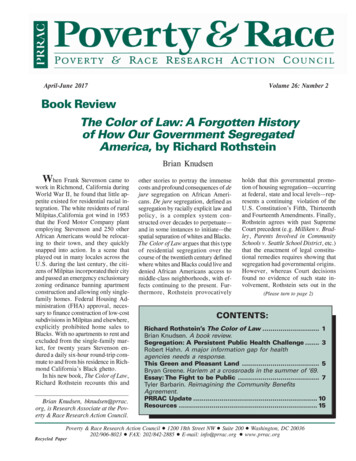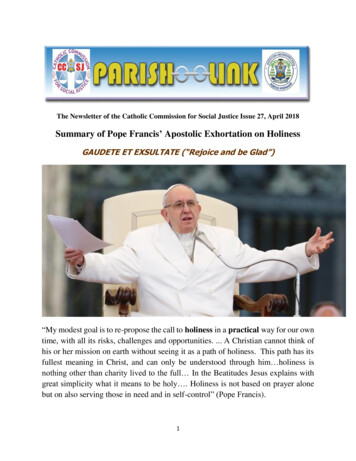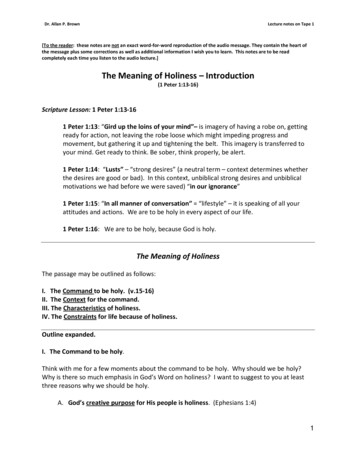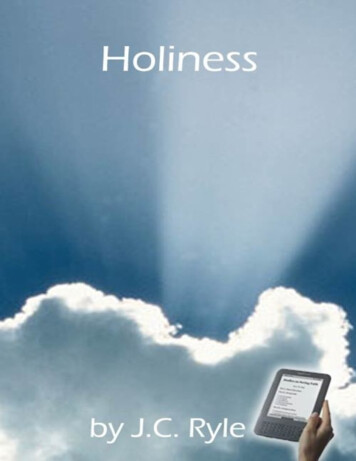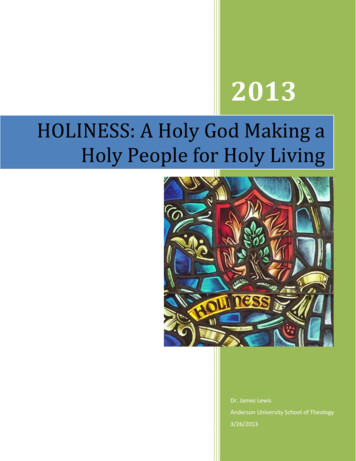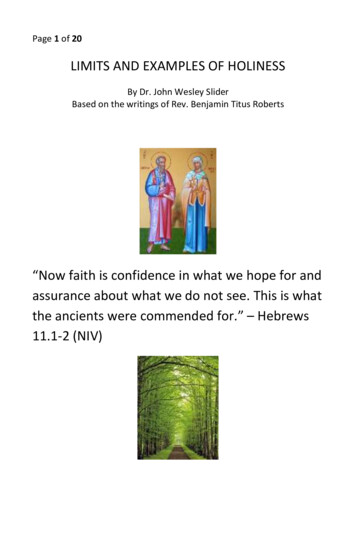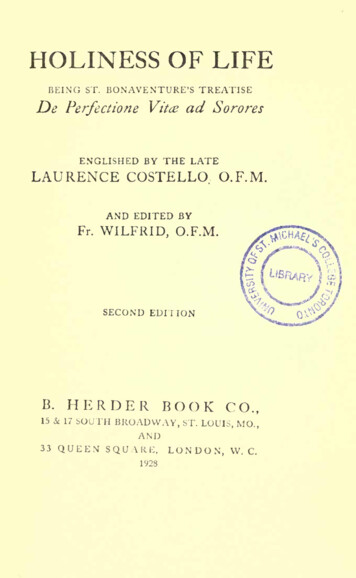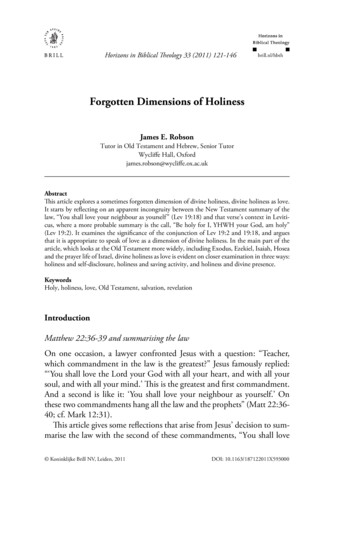
Transcription
Horizons in Biblical Theology 33 (2011) 121-146b ll l/hb hbrill.nl/hbthForgotten Dimensions of HolinessJames E. RobsonTutor in Old Testament and Hebrew, Senior TutorWycliffe Hall, Oxfordjames.robson@wycliffe.ox.ac.ukAbstractThis article explores a sometimes forgotten dimension of divine holiness, divine holiness as love.It starts by reflecting on an apparent incongruity between the New Testament summary of thelaw, “You shall love your neighbour as yourself ” (Lev 19:18) and that verse’s context in Leviticus, where a more probable summary is the call, “Be holy for I, YHWH your God, am holy”(Lev 19:2). It examines the significance of the conjunction of Lev 19:2 and 19:18, and arguesthat it is appropriate to speak of love as a dimension of divine holiness. In the main part of thearticle, which looks at the Old Testament more widely, including Exodus, Ezekiel, Isaiah, Hoseaand the prayer life of Israel, divine holiness as love is evident on closer examination in three ways:holiness and self-disclosure, holiness and saving activity, and holiness and divine presence.KeywordsHoly, holiness, love, Old Testament, salvation, revelationIntroductionMatthew 22:36-39 and summarising the lawOn one occasion, a lawyer confronted Jesus with a question: “Teacher,which commandment in the law is the greatest?” Jesus famously replied:“‘You shall love the Lord your God with all your heart, and with all yoursoul, and with all your mind.’ This is the greatest and first commandment.And a second is like it: ‘You shall love your neighbour as yourself.’ Onthese two commandments hang all the law and the prophets” (Matt 22:3640; cf. Mark 12:31).This article gives some reflections that arise from Jesus’ decision to summarise the law with the second of these commandments, “You shall love Koninklijke Brill NV, Leiden, 2011DOI: 10.1163/187122011X593000
122J.E. Robson / Horizons in Biblical Theology 33 (2011) 121-146your neighbour as yourself.”1 This reading of the law is found elsewhere inthe New Testament, in some cases, but not all, possibly deriving fromJesus. With the roles of questioner and responder reversed, it is the way inwhich a lawyer answered when Jesus questioned him (Luke 10:25-28). InGalatians 5:14, the apostle Paul writes that “the whole law is summed upin a single commandment, ‘You shall love your neighbour as yourself.’ ” Asimilar picture emerges in the epistle of James, where James writes, “Youdo well if you really fulfil the royal law (νόμον . . . βασιλικὸν) according tothe scripture, ‘You shall love your neighbour as yourself ’ ” (James 2:8).Leviticus and the NT summaryWe are so familiar with this answer that we might miss an incongruityabout it. The commandment that encapsulates (cf. ἀνακεφαλαιοῦται;Rom 13:9) the whole law is deeply embedded in the middle of Leviticus,in Leviticus 19:18. It is unlikely that the first readers of Leviticus wouldhave said that the slogan for Leviticus as a whole is “Love your neighbouras yourself,” despite Balentine declaring categorically that Leviticus 19:1718 is the “epicenter” of Leviticus, and Radday proclaiming that Leviticus19:18 is “the summit of the entire Torah.”2The speech in which this command is tucked away, if I can put it likethat, has as its opening call, קדשׁים תהיו כי קדושׁ אני יהוה אלהיכם , “Beholy, for I, YHWH your God, am holy.” It is this phrase that would havea strong claim to be the slogan for the book as a whole. Cothey summarisesthis well: “If we take Leviticus itself as our guide, then the book’s concernsare unified by YHWH’s demand that Israel be holy. The command to beholy features as some sort of explanation of the need to avoid uncleananimals (11.44); it prefaces a detailed but varied list of cultic and ethicalobligations (19.2); and it rounds off (at 20.26) YHWH’s explanation1)An earlier version of this paper was read at the Tyndale Fellowship Old TestamentSeminar and at the Oak Hill Graduate Seminar. I am grateful for all comments received.2)Samuel E. Balentine, Leviticus (Interpretation; Louisville, Ky.: John Knox Press,2002), 166; Yehuda T. Radday, “Chiasmus in Hebrew Biblical Narrative,” in Chiasmus inAntiquity: Structure, Analysis, Exegesis (ed. John W. Welch; Hildesheim: Gerstenberg,1981), 89. Though Radday does so on the basis of purported chiastic structure, it is thecontent that seems to dictate his conclusion.
J.E. Robson / Horizons in Biblical Theology 33 (2011) 121-146123of the respects in which ‘You shall not follow the practices of the nationsthat I am driving out before you (20:23).’ ”3There are a number of reasons why Jesus’ basing of the summary of thelaw on Leviticus 19:18 makes sense. First, it stands in continuity withsentiments expressed within the Judaism of Jesus’ day.4 Although there issome discontinuity, seen in the fact that the conjunction of quotationsfrom Deut 6:4-5 and Lev 19:18b is something new, yet the fact that alawyer trying to test Jesus makes the same conjunction warns against toosharp a distinction.5Secondly, there is the common call in both summary commandmentsto “love” ( ;ואהבת ἀγαπήσεις). Given the pivotal importance of the Shema,it should not be surprising that essentially the only other command to“love” in the Torah comes to be related to it as a hermeneutical key tounlock or summarise the law.6 The import of this commonality in the twocalls is most obviously evident in the lawyer’s summary in Luke, where thecommand ἀγαπήσεις only occurs once (Luke 10:27).Thirdly, there is a relationship between this summary of the law and theDecalogue. That Jesus recognises a strong link between them is clear fromMatt 19:18-19. There, Jesus quotes from the Decalogue, “You shall notmurder; You shall not commit adultery; You shall not steal; You shall notbear false witness; Honour your father and mother,” and then rounds offhis quotation by adding these words from Lev 19:18b, “also, you shall loveyour neighbour as yourself.” That same connection to the Decalogue isalso evident in Paul’s letter to the Romans (13:8-10).3)Antony Cothey, “Ethics and Holiness in the Theology of Leviticus,” JSOT 30(2005): 132.4)For which, see Reinhard Neudecker, “ ‘And You Shall Love Your Neighbor as Yourself—IAm the Lord’ (Lev 19,18) in Jewish Interpretation,” Bib 73 (1992): 496-517. R.T. France(The Gospel of Mark: A Commentary on the Greek Text [NIGTC; Grand Rapids, Mich.:Eerdmans, 2002], 477) observes, “The use of Lv. 19:18b in this connection is paralleled byR. Akiba’s statement that this text is ‘a great principle (k elāl ) in the Torah’ (Sipra Lv.19:18).”5)Cf. Darrell L. Bock, Luke (2 vols.; BECNT; Grand Rapids: Baker, 1994-96), 2:102526.6)The command for people to “love” ( )אהב occurs in the Torah in five places: Lev 19:18,34; Deut 6:5; 10:19; 11:1. The references in Leviticus relate to neighbour ( ;רע 19:18) andthen to resident alien ( ;גר 19:34). Those in Deuteronomy relate to loving YHWH (6:5;11:1; 2nd masc. sg.) and loving the resident alien ( ;גר 10:19; 2nd masc. plur.).
124J.E. Robson / Horizons in Biblical Theology 33 (2011) 121-146Alongside the summarising of the Torah with Leviticus 19:18, the possibility of summarising the Decalogue, and, beyond that, the Torah, interms echoing the injunction to “Be holy” should not be overlooked. Inthe Sermon on the Mount, Jesus exhorts his disciples, “Be perfect (τέλειοι),therefore, as your heavenly Father is perfect” (Matt 5:48),7 and Peter urgesthe scattered exiles, “Be holy yourselves in all your conduct; for it is written, ‘You shall be holy, for I am holy’ ” (1 Pet 1:15-16).Given the fact that these two summaries are grounded in Leviticus 19,and if it be granted that “Be holy, for I, YHWH your God, am holy” servesas the heading for Leviticus 19, a conclusion supported by the repeatedrefrains, אני יהוה or אני יהוה אלהיכם ,8 I want to ask the question of holiness, “What’s love got to do with it?”9Thinking about Holiness and Love: Some ChallengesThere are a number of possible angles from which to approach such aquestion. Rather than look at the shape of human holiness, and what isentailed by the command to Israel to “Be holy,” I want to look at the shapeof divine holiness, as revealed by the command to “Love your neighbour asyourself,” given that the call for Israel to be holy is grounded by the phrase, כי קדושׁ אני יהוה אלהיכם , “for I, YHWH your God, am holy.” To put itanother way, if “love your neighbour” is an expression of human holiness,and human holiness is analogous to divine holiness, then we would expectto find YHWH’s love to be an expression of his holiness. The “if,” though,is a big “if.” Within this straightforward syllogism there are some significant issues. The next part of the article will explore two of these issues:the complexity of the subject of holiness and the disputed ground of howanalogous are human and divine holiness. In the bulk of the article, Ishall turn to places where YHWH’s love is indeed an expression of hisholiness.Cf. Deut 18:13, “Be blameless ( תמים , MT; τέλειος, LXX).”See Jacob Milgrom, Leviticus 17-22: A New Translation with Introduction and Commentary(AB 3A; New York: Doubleday, 2000), 1723-24.9)With apologies to Tina Turner.7)8)
J.E. Robson / Horizons in Biblical Theology 33 (2011) 121-146125The complexity of the subjectTo discuss holiness is to enter a territory that is immensely complex andcontested for a number of reasons. First, holiness is never actually definedin the Old Testament, nor does it have an “analogue” in any other partof Israelite experience.10 Instead, the root ( קדשׁ and its cognates and antonyms) is embedded in narrative and law, speech and psalm, and we are leftto infer what is meant by it. Secondly, the concept of holiness varies somewhat between different corpora in the Old Testament. In his monograph,Holiness in Israel, Gammie, although discerning in the call to holiness acommon call to “cleanness” or “purity,” distinguishes between the contentof this call in priests, prophets and sages: “the kind of cleanness requiredby holiness varied. For the prophets it was a cleanness of social justice, forthe priests a cleanness of proper ritual and maintenance of separation, forthe sages it was a cleanness of inner integrity and individual moral acts.”11Thirdly, holiness is a fluid term in contemporary use.12 Fourthly, the territory is complex because it has been extensively scrutinised. It was the centre of the Old Testament theologies of Dillman, Hänel, and Sellin at theend of the nineteenth and the start of the twentieth century, before havinga centre became unpopular.13 It has also been the (or a major) subject10)For this last point, see Walter Brueggemann, Theology of the Old Testament: Testimony,Dispute, Advocacy (Minneapolis: Fortress, 1997), 288. G.B. Caird (The Language andImagery of the Bible [London: Duckworth, 1980], 18) suggests that language of “holy” maybe the only non-metaphorical language predicated of God in the Bible.11)John G. Gammie, Holiness in Israel (OBT; Minneapolis: Fortress, 1989), 196. Thissummary conceals the more nuanced perspective he gives on priestly holiness, where henotes the importance of the ethical dimension (p. 34). However, it is too harsh to call it a“simplistic statement” as Cothey (“Ethics and Holiness,” 133) does.12)See John W. Rogerson, “What is Holiness?” in Holiness Past & Present (ed. Stephen C.Barton; London: T&T Clark, 2003), 3.13)See John H. Hayes and Frederick C. Prussner, Old Testament Theology: Its History andDevelopment (London: SCM, 1985), 122, 167-68; Gerhard F. Hasel, Old TestamentTheology: Basic Issues in the Current Debate (4th ed.; Grand Rapids: Eerdmans, 1991), 159.Note, though, periodic reinstatements: Theodore C. Vriezen, An Outline of Old TestamentTheology (trans. S. Nenijen; Oxford: Blackwell, 1958), 151; Bernhard W. Anderson,Contours of Old Testament Theology (assisted by Steven Bishop; Minneapolis: Fortress,1999), 37-78; Allan Coppedge, Portraits of God: A Biblical Theology of Holiness (DownersGrove, Ill.: InterVarsity, 2001), 40, 361.
126J.E. Robson / Horizons in Biblical Theology 33 (2011) 121-146of Old Testament,14 New Testament,15 and biblical-theological monographs.16 Holiness has also been the subject of wide-ranging discussionfrom a phenomenological / psycho-religious / comparative religions viewpoint, with Rudolf Otto’s The Idea of the Holy seminal in this regard,17 andfrom an anthropological viewpoint, with Mary Douglas’s Purity and Danger a highly influential work.18 Given such complexity, to enter the frayhere is to leave many ends untied. This is compounded by the considerableliterature on Leviticus 19, in general, and Leviticus 19:18 in particular.19How analogous are divine and human holiness? The precise significanceof the conjunction of Lev 19:2 and 19:18bAlthough it is hardly controversial to say that loving one’s neighbour is anexpression of human holiness,20 there is a potential objection to the move14)E.g. Gammie, Holiness; Philip P. Jenson, Graded Holiness: A Key to the Priestly Conceptionof the World ( JSOTSup 106; Sheffield: JSOT Press, 1992); Israel Knohl, The Sanctuary ofSilence: The Priestly Torah and the Holiness School (Minneapolis: Fortress, 1995); JanJoosten, People and Land in the Holiness Code: An Exegetical Study of the IdeationalFramework of the Law in Leviticus 17-26 (VTSup 67; Leiden: Brill, 1996); Andreas Ruwe,“Heiligkeitsgesetz” und “Priesterschrift”: Literaturgeschichtliche und rechtssystematischeUntersuchungen zu Leviticus 17,1-26,2 (FAT 26; Tübingen: Mohr Siebeck, 1999); KlausGrünwaldt, Das Heiligkeitsgesetz Leviticus 17-26: Ursprüngliche Gestalt, Tradition undTheologie (BZAW 271; Berlin: de Gruyter, 1999).15)E.g. Craig L. Blomberg, Contagious Holiness: Jesus’ Meals with Sinners (NSBT; Leicester:Apollos, 2005).16)E.g. Jo Bailey Wells, God’s Holy People: A Theme in Biblical Theology ( JSOTSup 305;Sheffield: Sheffield Academic Press, 2000); Coppedge, Portraits of God.17)Rudolf Otto, The Idea of the Holy (1923; repr., Harmondsworth: Penguin, 1959).18)Mary Dougla
and the prayer life of Israel, divine holiness as love is evident on closer examination in three ways: holiness and self-disclosure, holiness and saving activity, and holiness and divine presence. Keywords Holy, holiness, love, Old Testament, salvation, revelation Introduction Matthew 22:36-39 and summarising the law

